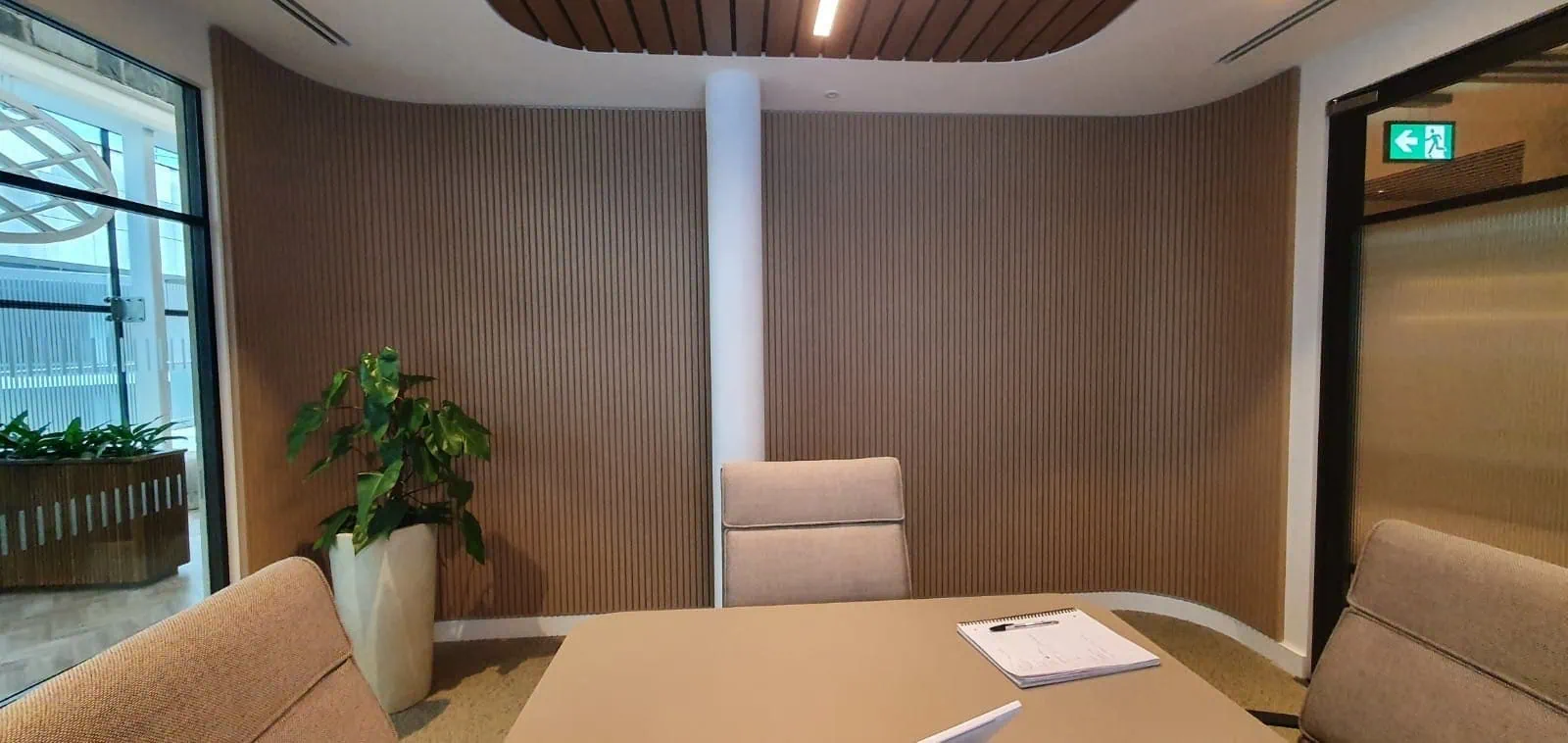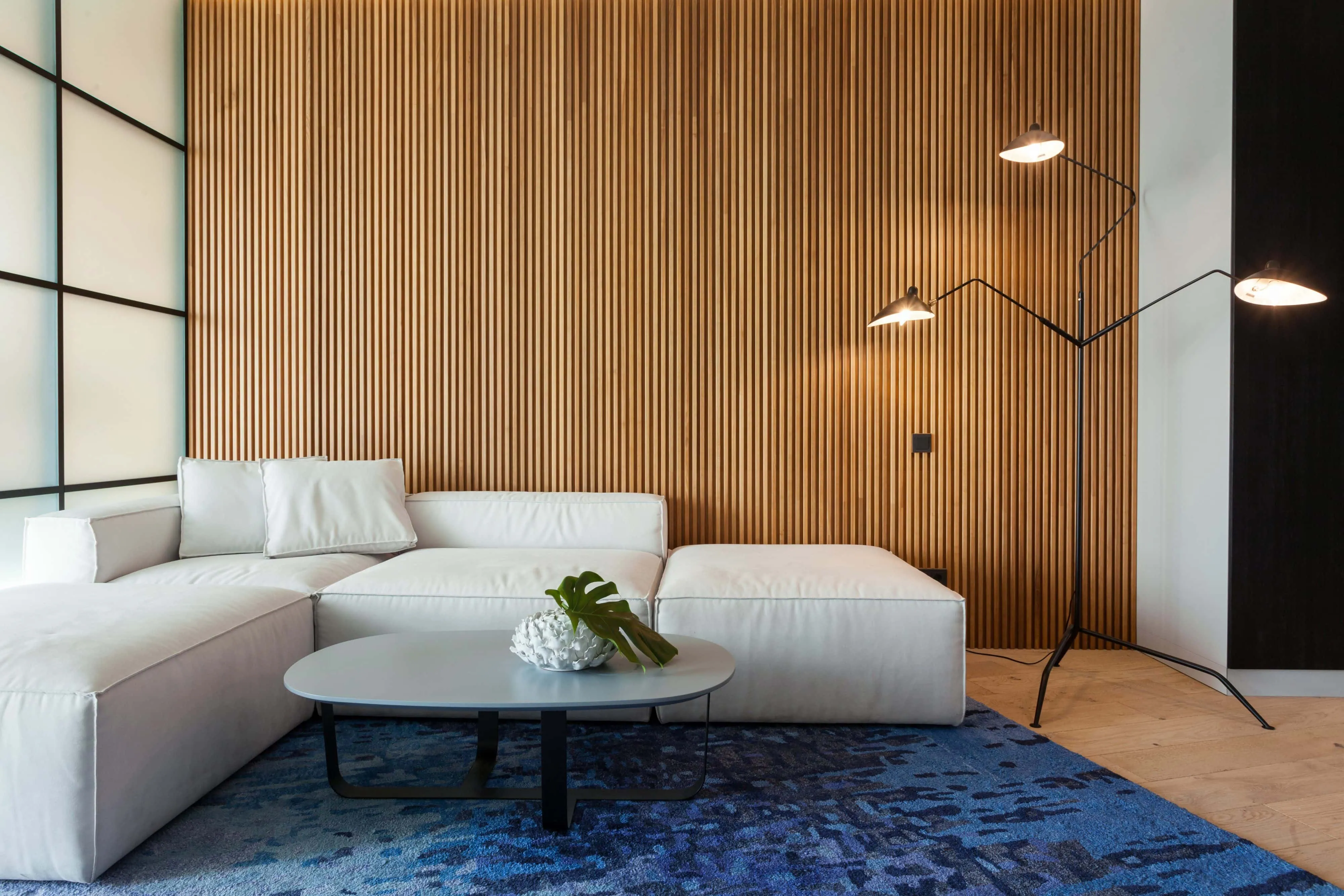Innovative Sound Control: Acoustic Wood Wall Panelling
Introduction
Are you curious to discover the secrets behind the success of acoustic wood wall panelling? Whether you’re working in a bustling open-plan office that requires focus or relaxing in a home theatre that demands an immersive audio experience, you will need effective acoustic control solutions.
Out of all the available options, acoustic wood wall panelling has become a popular choice thanks to its aesthetic appeal that captures the attention of architects and designers. But what makes these wood slat panels stand out? Understanding the science of sound absorption unveils the fascinating interplay between materials and acoustic performance. In this blog, you will find out what technical properties make wood slat wallpaper a better option for achieving superior sound control and what technical properties elevate them beyond their stylish exteriors, making them a preferred solution for superior sound control.
Principles of Sound Absorption
Understanding the fundamentals of sound absorption is crucial to assessing the proper value of wood slat walls. Imagine sound waves as ripples traversing through the air. When these waves encounter a surface, they interact in three primary ways: reflection, transmission, and absorption. While reflection and transmission can contribute to unwanted echoes and noise, absorption holds the key to creating a comfortable acoustic environment.
Absorbent materials like wood wall panelling effectively trap sound waves by converting sound energy into heat, mitigating echoes and reducing overall noise levels. The effectiveness of a material in sound absorption is quantified by its Noise Reduction Coefficient (NRC), with higher NRC values indicating superior sound control capabilities.

Technical Advantages
Thanks to their unique technical features, acoustic wood wall panelling are a highly effective option that enables the precise optimisation of important parameters such as slat depth, thickness, and spacing between slats.
As a result, acoustic performance has been significantly improved, and tailor-made frequency ranges can be achieved to meet specific aesthetic preferences. Furthermore, using wood as a renewable resource not only highlights its appeal as an eco-friendly acoustic solution but it also backed by certifications like FSC (Forest Stewardship Council), which guarantees responsible forestry practices. Sound absorption. The porous structure of these tiles, characterised by microscopic air pockets, naturally traps and dissipates sound waves.
Cost-Effectiveness and Value
Wood may require a higher upfront cost than alternative solutions, but they offer superior durability, longevity, and performance that justify the investment. These panels are engineered with precision and constructed from robust materials that exhibit minimal wear and tear over time. As a result, they require reduced maintenance costs and offer sustained acoustic enhancement.
Moreover, their aesthetic appeal and customisation options create an optimal listening environment, amplifying their overall value proposition. By considering a wood slat wall’s long-term benefits and superior performance, users can invest in sound management solutions that stand the test of time.
Wood Wall panelling Installation
Acoustic wood wall panelling is a practical choice for users seeking efficient solutions due to their versatility and ease of installation. They offer various mounting options, including direct mounting and suspension systems, which can be customised based on the layout and requirements of the space.
Proper installation is essential for maximising acoustic performance, and considerations such as panel spacing and orientation should be taken into account. Acoustic wood wall panelling is lightweight, which simplifies handling and installation procedures, empowering clients to undertake installation confidently.
By strategically placing panels in key acoustic reflection points, users can optimise sound diffusion and absorption, transforming the acoustical environment of any space.

Case Studies and Real-World Examples
Wooden acoustic panels have proven to be a highly effective and versatile solution for sound management, as demonstrated by various real-world examples:
- Offices: Open floor plans in offices can create a lot of noise and echo, leading to distracting and unproductive work environment. Wood slat wallpaper can be installed on walls and ceilings to absorb sound and create a more focused and productive work environment.
- Recording Studios: Recording studios need excellent acoustics to capture high-quality sound. Wood acoustic walls help control sound reflections and create a more isolated recording environment.
- Home Theaters: Similarly, home theatres benefit from wood acoustic walls to create an immersive and authentic cinema experience. Wood panels absorb sound echoes and unwanted noise, creating a crisper and more enjoyable movie experience.
- Restaurants: Restaurants can be quite loud, especially during peak hours. Wood acoustic walls can reduce noise levels and create a more pleasant dining experience for customers.
- Classrooms: Classrooms can also be noisy places. Wood acoustic panels can help improve speech clarity and reduce student distractions.
- Auditoriums and Performance Halls: Auditoriums and performance halls need to have good acoustics so that everyone in the audience can hear the performance clearly. Acoustic wood wall panels can help to achieve this by absorbing sound and preventing echo.

Light and Wood
Combining lighting solutions with wooden acoustic panels is an effective way to enhance both the visual and acoustic properties of a space. This integration creates a versatile ambiance that can adapt to different lighting conditions. By blending the two elements, you can create an aesthetically pleasing atmosphere while achieving optimal sound quality.
This intricate balance requires the selection of specific light fixtures and positioning relative to the wood panels, as well as the implementation of control systems that manage light intensity and colour temperature. The resulting customisation options allow you to create a warm, comforting atmosphere to ensure optimal visual and acoustic conditions in a professional setting.
The sustainability of materials and the energy efficiency of lighting solutions are also crucial, reflecting a commitment to environmental responsibility while providing aesthetically pleasing and functional spaces. This sophisticated integration of light and wood within acoustic panelling solutions represents the forefront of interior design innovation, where form and function are carefully combined to create spaces that inspire and delight.
Conclusion
If you’re looking for a way to improve the sound quality in your space, consider wooden acoustic panels. They combine both visual appeal and technical excellence to create a comprehensive, sound management solution. These panels absorb and control sound better than other options and are also eco-friendly and affordable. If you’re interested in learning more, check out our wooden panel selection or contact our team of experts for tailored guidance.


